Comparing Trucks
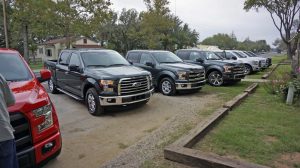 #5 Used Truck Judging 101: Now for the dark side. Used sales people are the lions in the grass waiting for the gazelle antelope to wander close. I’ve seen used sales folk throw customer keys on top of the store roof so they couldn’t leave without making a deal. I’ve seen sales people put the agreed price on a sales order with another sales order on top of it with a higher price to see if they got caught and if they did, then they’d pull up the bottom one and act innocence because the higher price was for another customer on another truck. I’ve seen a “buy here pay here” bad credit store buy an envelope of titles from cars that were crushed and use them for down payments for people without money down. But that was at a good dealership.
#5 Used Truck Judging 101: Now for the dark side. Used sales people are the lions in the grass waiting for the gazelle antelope to wander close. I’ve seen used sales folk throw customer keys on top of the store roof so they couldn’t leave without making a deal. I’ve seen sales people put the agreed price on a sales order with another sales order on top of it with a higher price to see if they got caught and if they did, then they’d pull up the bottom one and act innocence because the higher price was for another customer on another truck. I’ve seen a “buy here pay here” bad credit store buy an envelope of titles from cars that were crushed and use them for down payments for people without money down. But that was at a good dealership.
“Get Hard” the movie about a rich guy (Will Ferrell) hiring a poser to tuff in him up for prison, that’s what you need before going shopping for a used truck. Get that mean look that would scare John Wayne, do your research take control. Used trucks don’t have an invoice, most trades are taken in thousands below what the KBB blue book or NADA yellow book said the truck was worth and what trucks like it were selling at auctions around the country. Most of the trucks at a used lot come from the dealer auction. If it doesn’t sell on their lot, 30 days later, back to the auction it goes. Lemons, buybacks, flood damage, all the crap makes it to the auction. Very low mileage trucks might have spent most of their lives in the shop with chronic repairs. But with millions of used trucks out there, you can find good used trucks. I know is sounds old school, but late on a Saturday night on the last day of the month can still give you leverage negotiating.
I buy and sell vehicles on Craigslist for my collection, sometimes there’s a deal, sometimes it’s a scam. But I’ve seen good trucks there with real phone numbers instead of text messages to someone that’s selling the truck for their girlfriend and the game goes on and on. It’s all about patience and research. But judging a used truck for its condition is the same everywhere. Negotiating price, again is patience but you have to add some gangster attitude. One owner trucks that pulled light trailers and garaged their whole life would be ideal. Those ads might be in Craigslist or the local paper or even at garage sells in high end neighborhoods.
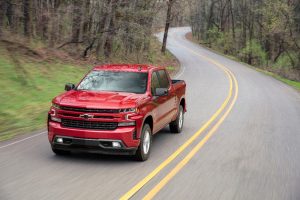
Judging your best-used truck! This is the report that requires work. You are in charge. You’re the customer. Find out the facts about the trucks that are important to you. When I sold trucks on a Saturday (big sale day) the service center would be closed. If I wanted to show a used truck where the customer wasn’t sure how good my truck was, I drove the truck into the empty service center. Then I pulled out 2 creepers, me and the customer would then slide under the truck and look for oil leaks and old mud caked in the frame from extreme off road use. Some used vehicles tour auctions from around the country and come from the last hurricane, tornado or flood area. It’s a smart thing to wonder about a truck that has sand and mud stuck to the starter and where do you suppose the seaweed wrapped around the U-joint came from? When you go to a used car lot, nothing stops you from bringing a creeper. Now get your creeper, flashlight, notepad and oil rag to have some fun on test-drives
When I was an auto broker with AAA Auto Club, some of the members we helped buy vehicles for, would bring along a mobile mechanic to check out a used vehicle. That’s a good idea, or take the used truck that you’ve narrowed down, to a trusted mechanic. The mechanic will have list of checks to know if the truck’s drive train is sound along with engines computers and sensors. If you are an AAA member, they have a great service to certify mechanics that you can trust.
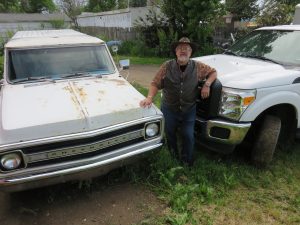 I’ve worked in dealerships for 10 years after leaving the farm. I saw people work so hard to get the right price on their truck, just to give it all back by buying an over inflated bogus warranty. The Right Warranty on your pickup can save you a lot of money. But don’t fall for the high pressure tactics to buy a warranty at the same time you buy your truck. You did your research on which truck you need., why would you buy a warranty from a stranger without a comparison and money back guarantee.
I’ve worked in dealerships for 10 years after leaving the farm. I saw people work so hard to get the right price on their truck, just to give it all back by buying an over inflated bogus warranty. The Right Warranty on your pickup can save you a lot of money. But don’t fall for the high pressure tactics to buy a warranty at the same time you buy your truck. You did your research on which truck you need., why would you buy a warranty from a stranger without a comparison and money back guarantee.
Your new used truck is an important decision that you don’t make often. This makes research a big part of your success. Your first research will be looking at reviews on the web. Then impartial forums to see what truck owners are saying about their last choice. Truck reviews on www.TFLtruck.com and www.MrTruck.com are good sources for truck reviews. Owner forum will give you truck owner opinions. For RV trailer towing trucks, www.RV.net is good, for trucks towing horse trailers, www.HorseTrailerWorld.com under the forum “trailer talk.”
So many things to look for on a previous owned truck. You’ve heard of looking at the hinges for over spray if it’s had a paint job. Bring a magnet in your pocket to find excessive body putty. You can take the VIN (vehicle identification number) of the truck to that trucks manufacture service center to look up recalls and the service record while under warranty.
Next take a good look at the seats and under the seat to see the springs. Note the thickness of the fabric and the stitching. Some fabric is sewn and glued to the foam and some is just stitched. The dealer is going to try to hide things, so look under the carpet mats, behind the rear seat. Look at the rubber gaskets around the doors and windows. Excessive wear where you get in and out of a truck will double check the mileage. Get a feel for how the inside controls are, can you reach them without be distracted from the road? It’s easier to get statistics on engines and drive-trains than the overall quality of a truck. Some years a better than others, some plants are better than others. Competition has improved dramatically in the last few years, which is the driving force for quality. In chapter 3 we talked about brand loyalty. I may not be able to convince you to switch truck brands. I wouldn’t mess with your religion. But this is important, on a used truck, the condition, past use, mechanical shape and miles can me more important than brand. Keep an open mind. Avoid the trucks that look like a workaholic. Do you know what the used truck you’re considering was doing in it’s previous life? Drag racing, towing ships, fording rivers maybe, or towing the space shuttle.
Some dealers will let you take the truck home. Then you can take your time looking under and all over it. This would be a good time to tow you trailer with it. The size of the truck you need depends of course on your needs. ½ tons and light duty ¾ tons are for light duty work, loaded part-time. Heavy-duty ¾ tons, 1 tons and above are designed to be loaded all of the time. They have twice as many tapered bearings that distribute weight in the rear axle housing. It’s called a full floating axle, similar to semi-truck eighteen-wheelers.
Full Floating Axle
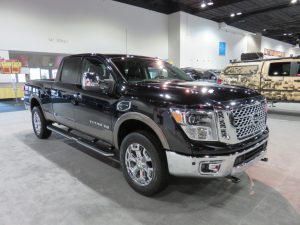 While ½ ton pickups have a semi-floating axle similar to a car, with just 2 bearings. ½ tons and light duty ¾ tons will have a flush axle housing matching the wheel. With the heavy duty ¾ ton, 1 ton trucks and larger, the rear axle housing will actually stick out past the wheel and have an additional 8 bolts on the end of the hub holding the axle into the wheel hub with the axle “floating” between the wheel hub and differential. Rolls Royce invented the “full floating” axle before WWII. Take a large screwdriver or pry bar to pop off the rear hubcap if you are looking at ¾ tons and larger. (full floating axle picture ) You will need to see if the truck has a full floating axle that sticks out on the Heavy Duties. GM, Dodge and Ford had some years in the eighties with light duty ¾ tons, (F250, 2500) which are ½ tons with more wheel studs and higher rear spring ratings, but not full-floating axles. Ford did it again with a 7-wheel bolt F250 in the early nineties. This could happen again.
While ½ ton pickups have a semi-floating axle similar to a car, with just 2 bearings. ½ tons and light duty ¾ tons will have a flush axle housing matching the wheel. With the heavy duty ¾ ton, 1 ton trucks and larger, the rear axle housing will actually stick out past the wheel and have an additional 8 bolts on the end of the hub holding the axle into the wheel hub with the axle “floating” between the wheel hub and differential. Rolls Royce invented the “full floating” axle before WWII. Take a large screwdriver or pry bar to pop off the rear hubcap if you are looking at ¾ tons and larger. (full floating axle picture ) You will need to see if the truck has a full floating axle that sticks out on the Heavy Duties. GM, Dodge and Ford had some years in the eighties with light duty ¾ tons, (F250, 2500) which are ½ tons with more wheel studs and higher rear spring ratings, but not full-floating axles. Ford did it again with a 7-wheel bolt F250 in the early nineties. This could happen again.
In chapter 4 there is a truck classification chart. Generally, a ½ ton truck is Ford F150, Ram 1500, GM 1500, Toyota Tundra, Nissan Titan. ¾ ton is Ford F250, Ram 2500, GM 2500. One ton is Ford F350, Ram 3500 and GM 3500.
The new in-between Nissan Titan XD has a semi-floating axle. The “semi-floating axle” has the wheel studs attached to it, carrying the trucks weight directly on the axle shaft and bearings. Differently on a “full floating axle” where the axle shafts only provide power to the wheel hub from the differential. The wheel hub is attached to the axle housing with two tapered bearings on each side. On a full floating axle you can pull the axle out and the wheels are steel attached to differential axle tubes. This puts the load carrying capacity on the axle housing not on the axle shaft as with a semi-floating axle.
Full Floating Axle, right two pictures, semi-floating on the left
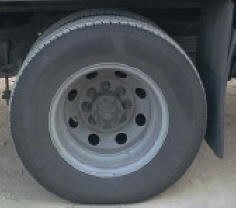
Heavy-duty ¾ tons, 1 tons and larger will have heavier springs, shocks and in some cases thicker, stronger frames. In recent years pickup truck manufactures have designed a different look between the ½ ton and ¾ ton. The majority of the time, if you compare a ½ ton to a ¾ ton pickup with the same gas engine option, the price is very close. And the ¾ tons will usually have more rear axle ratio and tow package options. Because of the value of a ¾ ton verses the price of a ½ ton, I usually recommend a heavy-duty ¾ ton. But keep in mind because of a slight weight difference and the higher axle ratio in a ½ ton pickup, that a ½ ton can have better gas mileage and a better ride. The EPA doesn’t test fuel mileage on ¾ ton trucks if they are over 8500# GVWR, (Gross Vehicle Weight Rating,) so you won’t find a fuel mileage rating on ¾ ton and higher trucks.
The Used Truck Judging List
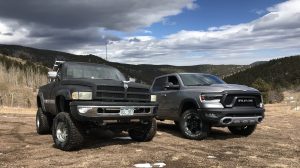 1.Shake rattle and roll. Does the truck vibrate excessively at idle? Does it shimmy at highway speeds? Is it needing just tire balancing or bigger parts? Oil slicks, I thought the oil went INSIDE the engine. Is oil dripping from the transmission, engine, differential, power steering, transfer case etc.? Are those same components wet with oil? In my younger years, we expected trucks to use and leak oil. Newer trucks do none of that. Anything else leaking, gas, antifreeze, brake fluid? Any smoke from the exhaust? Is it black, blue or white? Generally black smoke is from over-fueling a diesel for power as in aftermarket tuners, blue can mean oil ring wear with blow by and usually an engine using oil, and white smoke is usually steam as in water leaking from head gaskets. Any holes in the bed? Are they from toolboxes or a trailer hitch? See #5.
1.Shake rattle and roll. Does the truck vibrate excessively at idle? Does it shimmy at highway speeds? Is it needing just tire balancing or bigger parts? Oil slicks, I thought the oil went INSIDE the engine. Is oil dripping from the transmission, engine, differential, power steering, transfer case etc.? Are those same components wet with oil? In my younger years, we expected trucks to use and leak oil. Newer trucks do none of that. Anything else leaking, gas, antifreeze, brake fluid? Any smoke from the exhaust? Is it black, blue or white? Generally black smoke is from over-fueling a diesel for power as in aftermarket tuners, blue can mean oil ring wear with blow by and usually an engine using oil, and white smoke is usually steam as in water leaking from head gaskets. Any holes in the bed? Are they from toolboxes or a trailer hitch? See #5.
2.Get the TSB (Technical Service Bulletin) http://www.nhtsa.gov/cars/problems/trd/#TECHNICAL on the truck you’re looking at. It will show the recalls and what modifications are sent to dealer service departments to fix known problems. Not all of it may pertain to your truck. There is also crash tests and EPA mileage on trucks 8500 GVWR and lower.
3.Do a CarFax report on the truck. Some dealers are doing this now for you, this will show repairs and collisions. You’ll want to know if the truck has a clean title or salvage title. A salvage title is for a truck that was rebuilt from other trucks, like Frankenstein. It’s hard to finance a salvage title. Also take the VIN (Vehicle Identification Number usually on the left base of the windshield) to a dealer for the brand of truck you are looking at and have the service department check the history with the brands national database. Then you will know if there are any open recalls or known problems. And they can tell you if there is any remaining factory warranty left. Don’t assume if the truck has less than 36,000 miles that there is warranty left. Some factory buy-back lemons go to auction and back to a car lot with low miles and no warranty.
4.Find out the rear axle ratio. We discuss the formula for axle ratio in the last chapter. Most trucks will have the axle code in the driver doorframe or in the inside of the glove box door. There is usually a tag on one of the rear differential bolts with the ratio info on it, (another reason for bringing your own creeper.) When in doubt get the service department to help you decode it.
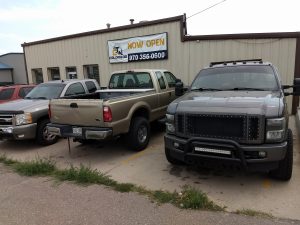 5.Look under the surprisingly new bed liner to see what the bed floor really looks like. A lot of the time the new bed liner is to hide the holes from the gooseneck hitch. Dealers quite often try to hide evidence of any kind of hitches. Some even take off the receiver hitches. I don’t worry if a truck has a rear receiver especially if it was part of a factory tow package. But a hole or holes in the bed where a fifth wheel or gooseneck ball was attached, might be a truck to avoid unless it’s exceptional in every other way. There is no way of knowing how big a trailer was pulled with the truck. Most of the folks I know, who pull trailers, usually pull a little too heavy. If the truck pulled a trailer that was thousands of pounds over the capacity, (like I would) it can strain the drive train and give you premature transmission, clutch, U-joint and axle replacement.
5.Look under the surprisingly new bed liner to see what the bed floor really looks like. A lot of the time the new bed liner is to hide the holes from the gooseneck hitch. Dealers quite often try to hide evidence of any kind of hitches. Some even take off the receiver hitches. I don’t worry if a truck has a rear receiver especially if it was part of a factory tow package. But a hole or holes in the bed where a fifth wheel or gooseneck ball was attached, might be a truck to avoid unless it’s exceptional in every other way. There is no way of knowing how big a trailer was pulled with the truck. Most of the folks I know, who pull trailers, usually pull a little too heavy. If the truck pulled a trailer that was thousands of pounds over the capacity, (like I would) it can strain the drive train and give you premature transmission, clutch, U-joint and axle replacement.
6.If you’re looking at an automatic transmission, be sure to look for an external transmission cooler. No I’m not talking about the lines that go through the radiator unless it’s a GM truck, but a separate cooler in front of the radiator. If you are sure the truck didn’t pull a trailer in a previous life, then you can add an external tranny cooler if the rest of the truck checks out.
7.Don’t forget to use dealer math on figuring out how old the truck is. Instead of 2017 the current year, minus the year of the truck you’re looking at, 2015 equals 2 years depending on the build date which is on the sticker inside the driver’s side door. Dealer math goes something like this, model year 2016-2015-2014-2013 = 4 years old instead of 2017, 2016, 2015, 2014 = 4 years old. Vehicles do a weird thing in the fall when the new model comes out. The used trucks all get a year older in September instead of January. Remember that, because book value will go down on your used trade in, so don’t forget to remind your opponent that the truck they are trying to sell you lost some value too. With 0% interest on new trucks, like last fall and this summer and fall, more trade-ins are flooding the used auto lots. Expect more selection and lower prices on trucks this fall. The price you get for your trade-in will certainly be lower. It works both ways don’t forget to remind the salesperson of that.
 8.You’ve been told this for years, but it’s still true. Sell your trade yourself for the most money. And it’s easier to know where you are in the deal. If you’re Colorado your sales tax is figured on the difference between your trade and what you are buying, except on a lease. Forget to take your trade-in. Just working with the numbers on one truck, not a truck and a trade-in clarifies what you are really paying. Dealers like to jack the price up on their truck and pretend to give you more than they really are for you trade. Then they can drop their price some and look good because they are giving you so much for your trade, (not). Add sales tax on the truck you’re buying to what you are getting for your trade or asking for your trade if you sell it yourself to see the whole picture.
8.You’ve been told this for years, but it’s still true. Sell your trade yourself for the most money. And it’s easier to know where you are in the deal. If you’re Colorado your sales tax is figured on the difference between your trade and what you are buying, except on a lease. Forget to take your trade-in. Just working with the numbers on one truck, not a truck and a trade-in clarifies what you are really paying. Dealers like to jack the price up on their truck and pretend to give you more than they really are for you trade. Then they can drop their price some and look good because they are giving you so much for your trade, (not). Add sales tax on the truck you’re buying to what you are getting for your trade or asking for your trade if you sell it yourself to see the whole picture.
9.If you look at a diesel, don’t forget to call the brand service department with the VIN again. The gas engine and truck has a 36,000 mile or 36-month factory warranty. The diesel by itself will have 5 year or 100,000-mile warranty from the factory. On a diesel it’s important to have the mechanic check the radiator fluid and maybe have it tested for metal and oil. And the other side, check the oil and see if any water in it. With diesels it’s important that the radiator fluid had a conditioner added at the right service interval. If the radiator fluid gets bad it can pit the sleeves and water jacket called cavitation.
10.If the VIN checks out and the service records show the truck is clean, look for any remaining factory warranty, what you find will be fixed, but if there are a lot of things wrong it will cost you too much time. Check the gaskets around the driver’s door, the threshold, the carpet and the pedals to see if the wear matches the miles on the odometer. Check the paint for over spray by the door hinges, hood hinges and where the fenders meet the liner. The fenders should match other body parts alignment and gap. Try each gear including reverse with the brake on to see how fast it engages each gear and how much play, (roll) it has. If it moves too much before you fill the axle move, you could have wear in the pinion gear or u-joints. If you hear too much noise in the tranny when you engage, then there is another problem. Once again if the truck has factory warranty, all these things can be fixed and you have peace of mind, I just don’t want to see you with chronic problems. The mechanic can check how the tranny engages. And the normal stuff, seeing what comes out of the exhaust, water, oil or carbon monoxide. Checkout the 4×4, if a shift on the fly, engage the button or dial, put in 4×4 hi with the hubs in auto or lock and do the circle to see if it hops. This is what you want. Unless it’s an all-wheel drive or full-time 4×4, it won’t hop driving in a circle. Then stop the truck and put in 4×4 lo and drive slower in a circle. And if manual 4×4 do the same with the floor lever and the hubs engaged. Some 4×4 trucks have solid front hubs like a front wheel drive car, so they are always on and you just engage the transfer case with a lever or switch.
11.A used diesel not maintained properly and over pulled beyond its factory weight ratings can be an expensive time bomb. Diesel mechanics charge more that gas engine mechanics per hour, engines, radiators, alternators, starters, batteries etc. all cost more in relation to gas engines. If a diesel truck wasn’t serviced properly with the more expensive than gas, filters, and cooling fluid additives etc. and if the truck pulled trailers way beyond the GCWR limits, which is common, then buying a 100,000-mile diesel truck may cost you a fortune. But a used diesel truck with a pedigree from a one owner pulling moderate trailer weights and service receipts is worth a premium. Some people use the high setting on chips and micro turners which works them hard to have most of the goody used up. That’s how most of my trucks were when I was done, I stripped them down to the frame and sold them by the pound.
Now in trucks, since they have better resale value and generally last longer, can priced even higher at one-year-old than new. I have seen that happen often. To see a significant difference, you need to go back 3 years in trucks. Crew cab 4X4’s are the resale kings. In 4X4’s used, can be a whole new experience. Since you won’t know how much off road use it had, a 4X4 can create its own payment! It seems that every part on the bottom of a 4X4 costs $2000. If you are the first owner of a truck, especially a 4X4 or diesel and you take care of it can last you decades. I see a lot of people buying diesels that don’t know anything about how to take care of them. Heavy duties are designed to be loaded all the time with heavier springs, frames, shocks, tire ratings, etc. Even the way they ride has changed dramatically in the last 5 years. In the old days, a ¾ ton truck rode like a basketball and needed some weight in the bed to ride better. A common misnomer is that ¾ ton truck cost more than a ½ ton truck. It’s true if the heavy duty is a diesel. But if both trucks have gas engines, they will be very close on price. Consider your future needs, maybe a bigger trailer or camper.
Being a rancher/farmer meant my truck had to pay for itself with use. Being overloaded most of the time is what got the job done. I hauled livestock, hay, wool, tractors, balers, backhoes, buildings, trees and whatever “kind of fit” the trailer. I was overweight, over width, and under trucked. No not me, the truck!
Now I want you to have the opportunity to have price discovery on the trucks you’re looking at, look at Kelly Blue Book, http://www.kbb.com/ and NADA http://www.nada.com/ there’s what used car managers use. To do this for free and often, use the websites. You can build new trucks with the options you want and also get used truck prices.
Always remember to get your money first. Used trucks don’t generally have 0% loans. New dealers will fund a low interest rate, used trucks stand on their own with banks. It’s whatever your credit can bear plus a couple points. Don’t forget you can basically give yourself low interest loans with an equity loan on your house and then deduct the interest off your taxes. Ask your bank or credit union for details.
Even if you don’t want a diesel or weren’t planning on a diesel, I just want you to know the facts. Diesels generally cost between $8,000 & $11,500 new as an option and bring closer to $4000 to $8000 more than a gas engine in a used truck. It generally takes 150,000 miles before the extra fuel economy of a diesel pays for the extra cost of a new diesel and transmission upgrade. And then the oil changes, fuel filter changes cost 2 to 3 times more; the noise and the smell if it gets on your hands while filling the tank. Diesel mechanics cost more per hour that gas mechanics. If I didn’t plan on keeping a truck for over 100,000 or tow trailers often, I wouldn’t get a diesel and I love diesels! But if you drive over 20,000 miles a year and love power when pulling a trailer then consider the diesel. Consider the extra cost of a diesel on a loan payment.
Auto transmissions in diesels in the past was an expensive lesson. The problem wasn’t so much the tranny but diesels are hard on drive trains. An auto transmission multiplies the torque from the engine through the torque converter. It’s easier to manage your speed in reverse with an auto tranny, even though in a 4×4 you can put the transfer case in low range to help a manual transmission slow down. With the modern trucks and hydraulic clutches you can’t tell the free play left on the pedal to check wear, but you can judge if the pedal backs almost all the way out before engaging. The farther out the clutch comes the more wear it has. The original factory warranty if still in effect will generally cover an automatic transmission repair, but rarely do warranties cover clutches.
The greatest weapon a salesperson has against you is your own emotions. Separate your excitement of a new to you truck. Salespeople are trained to ask about and use your “Hot Buttons.” Think of the truck as a chunk of metal and plastic, just like the salesperson does. Your opponent will use some logic to justify the emotional decisions they are pushing. Usually you will always find another great deal, so don’t get in a hurry. Make an educated, logical, wise economical decision. You can get all excited on the way home in your new to you truck and keep your kids college fund in your bank.
I’m amazed how passed down for generations, is the belief that a salesperson we just met, is a truck expert. I’ve been in the auto business for 10 years now, and have met very few salespeople who could give truthful, helpful answers to pickup truck questions. There is a place for sales and marketing and they are needed professions. But it’s not exactly fair, when you buy a vehicle every 4 or 5 years and your “trusted salesperson,” sells everyday! Trucks can last a long time, so can the wrong one. I’ve seen people hurt their credit rating by buying the wrong truck and then having to go back and trade in that wrong truck for a lot less than they just paid. Now they have the right truck and their payment is $300 higher. It’s always the nice people too! The tough truck buyers like in everything else get their invoice deal and move on.
Trucks can be confusing and most people end up asking their truck salesperson these important questions, and that salesperson more than likely will not know because they just started selling yesterday or last week and if they don’t just make something up to tell you, then they will “TO” turn you over to a manager you will smoothly tell you anything you want to hear. Very few managers in the auto business know anything about trucks, they just know how to smile and manipulate you with, “what can I do to earn your business today” and “sure that truck will pull your trailer, my brother-in-law pulls his with that exact truck.” Let knowledge be your first defense.
I suggest you get an owner’s manual after you buy your truck, to know what the recommended service schedules are. Helm is a good place to order you manual. It’s where dealers order theirs.
“The Right Truck.” I learned how to buy the right truck by; you guessed it, by buying the wrong one a few times! Since my first trucks were used, I had no idea of what the manufactures gross vehicle weight rating or warranty requirements where all about. I hauled 3000 pounds in my ½ ton, 5000 pounds in my ¾ ton, and 10,000 pounds in my 1 ton. OOP’s, that was probably a little too much. That could explain why so many u-joints, clutches and brakes.
It’s hard to recommend which truck without knowing what you are going to use it for. Half tons are generally used for the light work, loaded occasionally. Three quarter ton’s and one ton’s can be loaded all the time just like their cousins the 18-wheeler. The heavy-duty ¾ and 1 ton’s use to only ride nice when they were loaded. They have come a long way baby. Now they all ride like cars kind of. In the big cites people use them as cars. When I first came to Denver I was amazed to see 5-year-old pickups with no scratches in the beds. My pickups didn’t last the first day without a scratch. After you drop the first salt block and the first big round bale, the bed just doesn’t look the same.
It’s your money, your time, and your fun! I’ve driven my share of daily driver trucks lasting over +20 years or more. I’ve got a 1970 Chevy C10 now, that I’m restoring and plan to use as my parts runner. And Friday nights we’ll take it to Sonic drive-in and tell wild lies about all the work I did on it.
I believe in long test drives and several of them. Always remember it’s your money and you are in control.
Disclaimer: This report contains my experience, opinions and research. Use this as a guide to make an intelligent choice on your own.

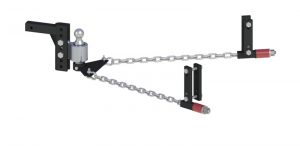

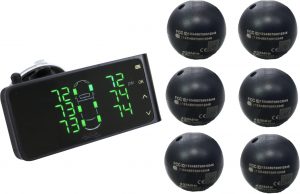
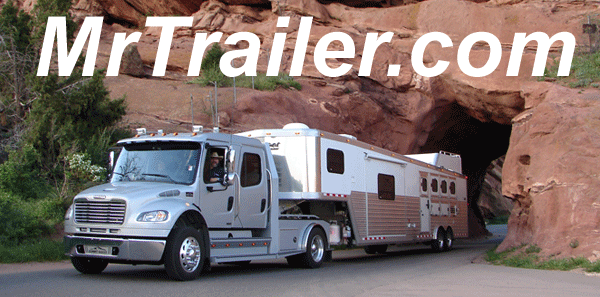




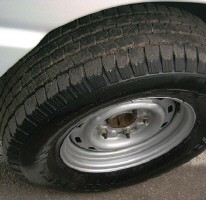
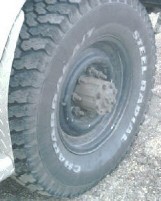


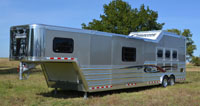
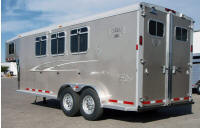
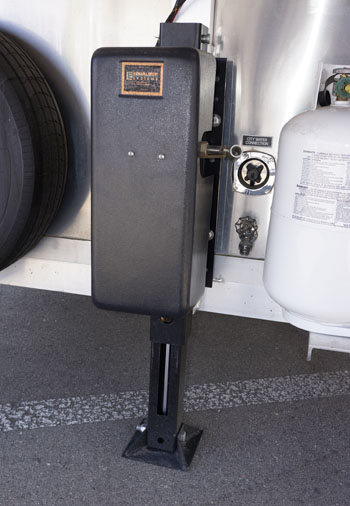
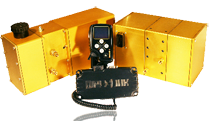
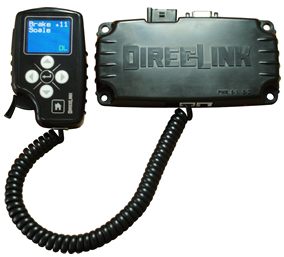


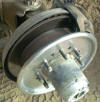 Automatic Tire Balancers for Trucks and Trailers25% to 50% longer tire life,
Automatic Tire Balancers for Trucks and Trailers25% to 50% longer tire life, 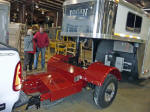 Automated Safety Hitch
Automated Safety Hitch 
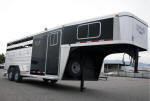

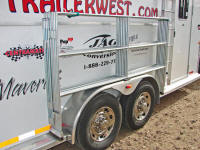

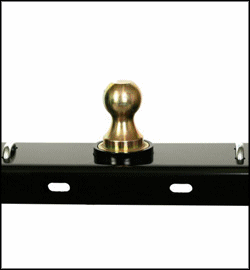
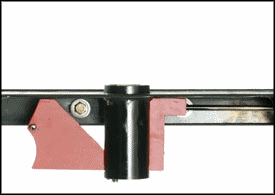
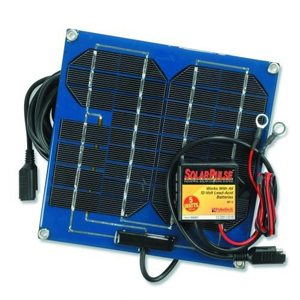



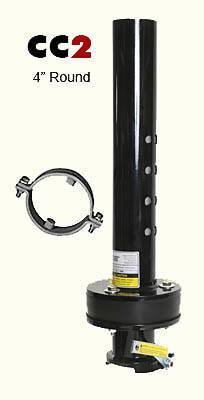 Popup Cushion Coupler Happy Horses Smooth Trailers
Popup Cushion Coupler Happy Horses Smooth Trailers
